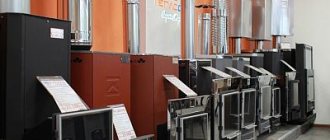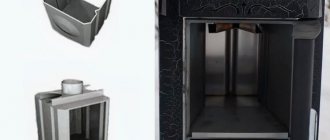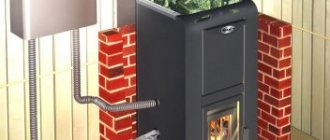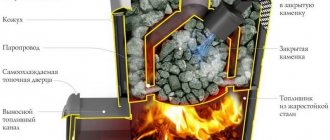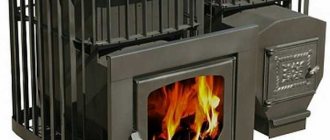A gas sauna stove is a convenient and economical heating option. For Russian users, this method is somewhat unusual, since it does not apply to traditional options for arranging a bathhouse.
However, the use of gas furnaces allows for quick and economical heating, the ability to use different types of fuel (natural or liquefied gas), and the absence of the danger of carbon monoxide poisoning. At the same time, gas furnaces have their own specifics, which do not allow frivolous or inattentive attitude. The issue is serious and requires careful consideration.
4.5/5 — (2 votes)
Specifics and features
A traditional wood-burning stove in a bathhouse has two important drawbacks: it takes a long time to heat up and can become a source of deadly carbon monoxide.
A gas oven is a modern and efficient alternative to traditional ovens. It is much more convenient to use, costs less and has previously known performance qualities. This distinguishes gas stoves from traditional wood stoves, each of which has its own characteristics.
In addition to rapid convective heating of air, a gas furnace can heat water. In this case, two modes are possible - flow and heating in a storage boiler connected to the burner. Both options give quick, high-quality results, and are often used in pairs.
The heating itself is always carried out in flow mode, but in one case the water immediately goes to the point of analysis, and in the other it enters the container, from where it is supplied again to heat and maintain the set temperature.
The operation of gas furnaces is characterized by uniformity and stability. However, the specific design and design features of the burners may have their own subtleties. In addition, there are furnaces that are completely autonomous and require connection to the power supply network (for the operation of auxiliary control systems).
Therefore, for the correct selection and safe operation of the furnace, it is necessary to understand its structure and operating principle. Otherwise, failures or emergency situations with unpredictable consequences are possible.
Documents that need to be completed to operate a gas sauna stove
fire certificate for gas stove
The first document that you must have is a certificate for the purchased equipment: burner or stove . Anything purchased in a store already has such a certificate.
Another important thing is this: the delivery package of the burner may include a hose with a reducer and other parts for connecting to bottled gas, which, if desired, can be purchased separately, but you need to know that if purchased separately, each part will need a certificate. This will complicate the permitting process.
When the equipment is installed but not yet connected, you need to call an inspector for an inspection . He should check everything and, if necessary, point out what needs to be corrected. After receiving the inspection result, a bypass of other authorities begins, the result of which will be obtaining a permit to operate the stove, which is issued by Rostekhnadzor.
The requirements for naturally aspirated models are stricter than for supercharged ones. In addition to fire safety measures and chimney insulation, as well as the presence of a spark arrestor at the end of the pipe, which applies to any type of burner, the draft and ventilation device will be checked.
Advantages and disadvantages
Statistics show that gas models are the best-sellers among all types of sauna stoves.
This success is due to the many advantages of gas furnaces:
- rapid heating of rooms and water;
- fuel costs are lower than alternative models;
- gas consumption is much lower than the amount of solid fuel or electricity required to heat the same premises;
- there is no need to monitor the combustion process and constantly add fuel - simply, the combustion mode is adjusted, and the process proceeds automatically;
- the steam room (and the room in general) is clean, there is no soot or ash;
- the ability to quickly and accurately adjust the temperature;
- light weight, no need to build your own independent foundation
- the presence of heat-protected chimneys, passage units through the ceiling and roof;
- ease of operation. There is no need to constantly remove ash and clean the ash pan;
- small size, the stove does not take up useful space from the main room of the bathhouse;
- a large number of models of different capacities with a wide range of functionality.
Disadvantages of gas furnaces:
- the need to obtain permits for the operation of gas equipment and carefully follow the operating rules;
- accidents are possible caused by violations of operating rules or the use of low-quality devices;
- After turning off the stove, the temperature in the bathhouse drops quite sharply.
Despite some shortcomings, the demand for gas sauna stoves is steadily increasing. The undeniable advantages of such equipment make gas furnaces the most popular and preferred among all possible options.
The most famous Russian companies producing gas furnaces
We are not interested in promoting any of the manufacturers, so we simply inform you that the Russian enterprises Teplodar and Termofor have ready-made gas stoves:
"Teplodar"
Stoves “Taman”, “Rus”, “New Rus”, “Laguna”, “Sibir”, “Sahara”, “Sibirsky Utes” have not only wood-burning, but also gas modifications. Some models from these lines are considered separately: Laguna-12 TK, Rus 9 LU, Rus 12 L, Sahara 24 LC.
"Termofor"
The Termofor company also has a couple of stoves with gas equipment. “Taimyr” is also on the site.
*** Well, if you are not afraid of the hassle of paperwork, a gas stove can really save a lot of work and money (this will come later, but at first you will have to spend a lot of money). But do not forget about the main thing - safety , because today we have all the means to prevent a household gas explosion.
How it works
A gas sauna stove operates on the general principle of gas devices - gas is supplied to the burner. When burned, it releases a large amount of thermal energy, heating the air in the room and water for hygiene procedures.
The main element of the furnace is the gas burner. For sauna stoves, it is specially made and has an elongated shape to accommodate the device in a remote firebox.
The use of conventional stoves in a bathhouse is undesirable - it is easy to get burned on the body or complicate ignition in stoves of a conventional design.
The gas burner is located in the combustion chamber. A copper coil is placed inside it to heat the water. In addition, there may be a heat exchanger for flow heating. A chimney is connected to the combustion chamber, which is then connected to a sandwich pipe and a passage through the ceiling (as a rule, they are purchased separately).
All nodes are located in a common housing. A grate or mesh for the heater is installed in its upper part. The weight of a gas stove (without additional components and heater) is relatively small - approximately 50-70 kg (although variations are possible). For installation, it is enough to provide a strong fireproof (ideally, heat-insulated) platform.
Blitz tips
- Do not leave any type of sauna stove unattended.
- Use firewood that has reached the optimum moisture content.
- Follow the operating instructions in all situations.
- Do not store the gas cylinder in the steam room.
- Remember, it is better to buy a stove with increased power than to steam at an uncomfortable temperature.
- Before purchasing an electric stove, make sure that the electrical wiring is in good condition and the power input is sufficient for normal operation.
- Clean the chimney in a timely manner.
- If the device burns out, immediately stop further use.
- Never block the chimney while the fire is burning!
Criterias of choice
Choosing a gas furnace is a responsible task that requires preliminary calculations and knowledge of design features.
The selection criteria are usually:
furnace power
It is necessary to first calculate the required power, taking into account the volume of the room, correction factors for decoration, windows, number of rooms (compartments), etc. The power is selected based on the volume (on sale it is usually indicated for which rooms a particular model is suitable);
burner type
Manufacturers claim that the best option is a supercharged design. However, it has a lot of features that complicate operation. In particular, high-quality grounding and a voltage stabilizer are required. Therefore, atmospheric burners are more often chosen - they are unpretentious and only need stable draft;
water heating method
Double heating is preferable (in a container and in a flow-through method), but here they are guided by their own needs and considerations;
fuel type
Most designs can operate on both natural and liquefied gas. However, most burners require reconfiguration from one type to another, change of burner nozzles and other procedures. They can only be performed by specialists from the service center.
Expert opinion
Lovkachev Boris Petrovich
Bath master who knows everything about steaming
Taking these criteria into account and comparing them with the characteristics of commercially available gas furnaces, the optimal option is selected. An important factor is also the price of the stove, which many users consider the main selection criterion. Here any recommendations are useless - they are guided by their own financial capabilities.
Gas-wood boiler
For those who cannot imagine visiting a steam room without the unique smell of burning wood and want to save on the operation of the bathhouse, a gas-wood stove may be the ideal solution.
Such a heating device is a modern universal design that allows the use of various types of fuel: natural and liquefied gas, coal and wood. This is possible due to the fact that such stoves have removable elements necessary for working on solid fuel and gas.
Devices designed for gas combustion consist of burners, filters and various valves. At the same time, to operate a solid fuel stove you need a fuel receiver. Such heating devices are not new on the modern market. They were used back in Soviet times. A striking example of this is the OGV (heating gas water heating) boiler.
The equipment necessary for gas combustion is installed in the ash pan of the furnace. If it is dismantled, the boiler will function properly using solid fuel.
Gas-wood stoves are very popular not only due to their versatility. Their cost is at an acceptable level, which is an important factor for bathhouse owners.
Best models
There are a large number of gas-fuelled sauna stoves on sale.
Most of them are domestically produced, and this is no coincidence - imported designs do not work well in our conditions. They need a stable supply of electricity, since almost all designs are supercharged. In addition, spare parts and replacement units for such furnaces are too expensive, which sharply reduces user interest.
Domestic furnaces are designed taking into account technical conditions and operating features. They are relatively cheap and unpretentious, have stable parameters, are durable and reliable. Therefore, user interest is focused specifically on domestic equipment.
Let's study the rating of the most popular models of gas stoves for baths:
Kutkin G-4.0
Oven with a power of 40 kW, weighing 85 kg (without stones). Capable of heating a heater weighing 120 kg. Designed for rooms with a volume of 40-75 m3.
- Pros - economical fuel consumption, the presence of 4 operating modes, the ability to adjust air convection without over-drying, heating the heater from 5 sides.
- Disadvantages - narrow range of burner settings, possibility of overheating of the stove (the housing material is not designed for long-term operation at maximum conditions), no steam generator.
Troika No. 06-GT80
Special design with a closed heater. This allows for maximum heating without loss of thermal energy. The furnace power is 80 kW, designed for use in a room with a volume of 40-70 m3.
- The advantages of the stove are high power and the ability to remain heated for a long time, no danger of getting burns from the hot body, no overheating and no drying out of the air.
- Disadvantages - heavy weight, requiring the manufacture of your own foundation, mandatory brick lining, large oven size.
Ermak Uralochka 30
Modular oven with a power of 30 kW, designed to operate in rooms with a volume of 24-30 m3. The 4mm thick body ensures durable and stable performance. The maximum weight of the heater is 110 kg (recommended - 70 kg).
- Pros : energy independence, intense air heating, ability to obtain dry and wet steam.
- Disadvantages - the resource of the water tank is relatively small, the weight of the stove is too large.
Teplodar Sahara-16
An efficient oven with a power of only 26 kW. At the same time, it is capable of heating a steam room with a volume of 8-16 m3 in 30 minutes to a temperature of 110 °C. The design is well thought out, the operation of the furnace in all modes is stable and trouble-free.
- The advantages of the stove are a multi-mode type of operation, the presence of wood power in parallel with a gas burner, the possibility of remote control, and compactness.
- Disadvantages - lack of a steam generator; the furnace lining wears out before the structure itself.
Izistim Yalta 35
A high-quality stove capable of long-term conservation of thermal energy even after shutdown. Capable of heating a bathhouse with a volume of 30-40 m3 in 1 hour 50 minutes (in winter, 30 minutes faster in summer). Power - 40 kW.
- The advantages of the stove are its durability, large heater, and a built-in steam generator.
- Disadvantages : heavy weight, limited fuel burning time to 10 hours.
Only the most popular models according to online stores are considered. The range of gas stoves is much wider; there are many alternative offers. When choosing a suitable stove, you should first consider its characteristics.
It is not advisable to be guided by popularity or position in the ranking - often such indicators do not correlate well with the true qualities of the equipment.
Questions and answers
The selection and operation of a gas stove for a bath requires experience and skills in operating such equipment. At first, a lot of questions arise, and most of them are the same. It is easier to answer them immediately to eliminate the risk of errors.
Which gas stove burner should you prefer during the selection process?
There are many options here. First of all, you should not be guided by the name of the manufacturer - you need to pay attention to the design of the device and consider how it is installed. The burner flame should not touch the metal of the body or firebox - this will cause rapid burnout and failure of the stove. The best option would be a micro-flare burner, the efficiency of which is in no way inferior to conventional models, but there is practically no danger of burning through the walls of the furnace.
What is more convenient, atmospheric or closed (pressurized) burner design?
Atmospheric structures can be used if the volume of the room exceeds 12 m3. In addition, they are highly dependent on external conditions, require stable draft and are often capricious due to drafts. However, if normal conditions are created for them, the furnace operates stably and does not require electricity. Closed burners require power supply (ventilation, control, control of the combustion process). At the same time, they have much less danger of self-extinguishing.
How to choose the furnace power?
The power of a gas furnace must be calculated. This is a difficult procedure, requiring calculation of the volume of premises, adjustments for the size and number of windows, finishing materials, etc. Independent calculation is difficult, but you can use an online calculator (there are many of them on the Internet, you can use several resources to clarify the results). You can do it simpler and calculate the furnace power based on the ratio of 1 kW per 1 m3. However, this method will give too approximate (and possibly erroneous) results.
What is the fuel consumption of a gas furnace?
This parameter is individual for each model. Average indicators here provide too little useful information, since gas consumption depends not only on the size or configuration of the premises. Here it is necessary to take into account the combustion mode, water heating losses and other specific features. However, for orientation, we can proceed from average values - a 10 kW furnace in average mode consumes 0.85 m3 of liquefied gas or 1 m3 of natural gas per hour of operation.
What is better, to choose an imported or domestic gas stove?
Imported stoves are expensive. In addition, they are too dependent on the quality and pressure of the fuel, the stability of the power supply, grounding and other technical details. Therefore, it is more profitable and correct to purchase an unpretentious and inexpensive gas stove of domestic production.
How often should furnace maintenance be done?
This depends on the load, device parameters, its design and operating conditions. The frequency of maintenance is indicated in the device passport. It is not recommended to ignore the manufacturers' instructions. If exact data is not available, prophylaxis should be carried out once a year. To do this, you should call a technician from the service center or a gas service technician.
Nuances to consider before installing a gas stove
We have not touched upon the topic of making a gas oven yourself for one simple reason:
IMPORTANT! Homemade gas stoves and gas burners are not certified ; they are prohibited for use by law . In case of violation, you will have to pay fines.
The only thing in your power is to buy a ready-made burner and prepare the stove for gasification. Compliance with the following standards should be checked:
- the firebox must (!) go into the dressing room, and the firebox opening is finished with iron;
- dimensions of the firebox opening: 47-55 cm in height, 35-45 cm in width, and if together with a metal frame, then 61-68 and 51-66 cm, respectively;
- The minimum room volume for installing a gas stove is 8 cubic meters. (Remember, yes, that atmospheric ones are installed with a volume of at least 12 cubic meters);
- the height of the room cannot be less than 2.2 m;
- It is necessary to have a window with an area of 0.6 sq. meter, a gap under the door to the steam room from 4 cm or a ventilation grille;
- the refractory material under the stove must be at least 10 cm wider than the dimensions of the stove on each side;
- combustible walls should not be closer than half a meter to the heating device.
IMPORTANT! All work related to gasification is carried out by professionals .
